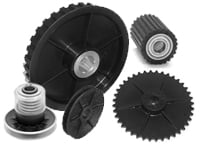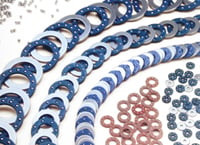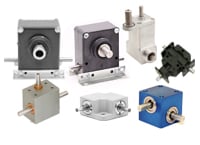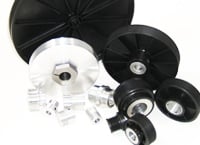This article, written by Tom Cartwright, originally appeared on Ezine Articles. com.
In any application where there is a drive, driven or idler pulley, engineers and designers need to consider the properties of the materials used in timing pulley construction before committing to a final design. Nylon and aluminum are the two most common construction materials for timing pulleys. Both materials have their advantages and disadvantages depending on the application.
Nylon timing pulleys are lightweight, offering excellent inertia control which in turn enhances energy savings. They feature good wear characteristics, inherent chemical resistance, material cost savings and have no oxidation issues.
Aluminum timing pulleys are also considered lightweight, although heavier than nylon. They have moderate inertia control, and display excellent wear characteristics. They are mechanically durable, but have some oxidation issues if untreated (clear coat or anodizing).
Additives to the nylon can give the end user important, and sometimes necessary, properties including material that is UL94-V0 flame retardant, FDA and RoHS compliant or non-conductive for static sensitive processes. Nylon pulleys, timing or otherwise, have no magnetic signature. Depending on the application, the tensile strength of nylon, although less than that of aluminum or steel, is often more than sufficient for low or fractional horsepower drive systems.
For designs where timing pulleys may have to endure temperatures exceeding 120 degrees Celsius (250 degrees Fahrenheit), nylon pulleys are mechanically sound, but are approaching a temperature where material deflection is a possibility. Most synchronous timing belts have a maximum recommended operating temperature of around 82 degrees Celsius (180 degrees Fahrenheit). Although cost savings might make a nylon pulley attractive, in high temperature applications aluminum may be the wiser choice. In either case, the limiting factor will be the temperature at which the chosen belt will fail.
Nylon is a little less then 2.5 times lighter (g/cc) than aluminum when comparing solid shapes. But, when it comes to properly designed timing pulleys, nylon can be as much as five times lighter than aluminum, yet capable of achieving the same torque and speed requirements.
How is that possible? Just as the majority of aluminum automobile wheels have four to six spokes to save cost and weight without compromising strength, balance or performance, the same principles apply when it comes to designing and molding nylon pulleys.
The web of the pulley and the hub are designed for strength, material savings, and cost savings. For some nylon pulley profiles, an aluminum web is used to eliminate deflection, increase strength and minimize the potential for deformation during the cooling cycle after molding. Nylon timing pulleys can be supplied as all plastic or plastic with an over molded metal insert. These metal inserts can be provided using aluminum, steel and stainless steel and can be keyed, broached, splinted or have set screws just like a solid aluminum or steel pulley.
Both nylon and aluminum pulleys can be provided with single or double row radial bearings pressed into the hubs. Both can also be supplied with single or double flanges and offer a wide variety of the most common tooth profiles. Nylon pulleys can be provided as stepped pulleys when two or more different pitch diameters are pressed on to a common bushing and staked into place.
Due to the continual drive for efficiency and cost savings in the automotive and other industries, it is very common to find plastic pulleys under the hood of your car, in your table saw or even driving your lawnmower. The plastics industry has come a long way in the past twenty years. New additives and fibers are now available which allow material characteristics to be fine-tuned for specific applications in a wide range of industries. In many cases, they offer equal or superior performance than their metal counterparts.
 Torque Transmission manufacturers timing pulleys in a variety of standard size and custom sizes - All provide superior performance and economic design. Because our timing pulleys only require a minimal amount of belt tension to prevent slippage, the bearing loads on the driving shaft are greatly reduced.
Torque Transmission manufacturers timing pulleys in a variety of standard size and custom sizes - All provide superior performance and economic design. Because our timing pulleys only require a minimal amount of belt tension to prevent slippage, the bearing loads on the driving shaft are greatly reduced.
Molded drive pulleys from Torque Transmission are reinforced with metal inserts to offer the lightweight advantages of nylon along with the advantages of a metal-to-metal connection at the hub.
Article Source: http://EzineArticles.com/?expert=Tom_Cartwright
Article Source: http://EzineArticles.com/4883980







